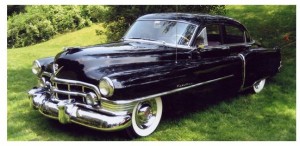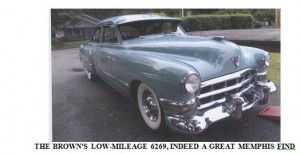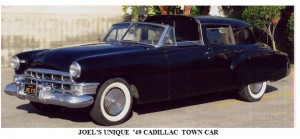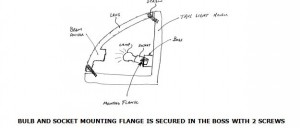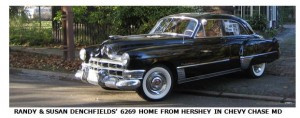Several ‘49ers who own(ed) a ’49 now own a 1950 Cadillac, including this 6169 4-door belonging to Jim Murdoch of Hanson MA. ’50 Cads have the same steering wheel, shift lever and tail lights as a ’49 and a similar dashboard, but the body and chassis are otherwise a complete re-design. Except for a slightly different carburetor, the ’50 engine, the transmission and differential are identical to the ’49 versions, but few other mechanical parts will interchange. A notable improvement in 1950 was modern tubular shock absorbers that are much easier to work on than the lever-type shock absorbers in use since 1934.
Monthly Archives: December 2009
FINDING A 49 IN MEMPHIS, TENNESSEE
On Saturday, October 10th, 2009, we drove to Memphis (from N. Little Rock, Arkansas) to take a look at a ’49 Caddy Series 62 4-door, Baby Blue in color. We had been told about it by a fellow car club member. The car was bought new in that city, and has been a Memphis car its whole life. We saw it, thought it was gorgeous, had our minds made up and, needless to say, we left Memphis with that ’49 Cadillac.
We bought it from the third owner of the vehicle, and they had purchased it in 1989 when it had 62,000 miles on it. It now has 67,000 miles and is rust-free. The interior seats are completely original, the carpet has been replaced at one time, but since Tom is in the auto upholstery business we will have that restored. Fortunately, he put it up on the lift at the shop the following Monday and found that the right rear shock had all but come loose, so new shocks were ordered immediately. Probably the best part of buying a car for us is restoring it to as near the original as possible. We are looking forward to getting it ready and going to the Cadillac Grand National Meet in 2010
IF YOUR AMMETER IS NEITHER POSITIVE NOR NEGATIVE, BUT IN BETWEEN THAT IS, DOESN’T WORK
…it’s not hard to fix. An ammeter will stop working for several reasons, a common one being that one or both of its two wires are broken, frequently within the wire harness sheath where it can’t be seen. To get it to work again, try running two new wires to it as follows:
1. Get about 10 feet or so of 16 gauge wire and, if you don’t already have this stuff, a box of assorted crimp-type connectors and a combination wire cutter, stripper and crimping tool;
2. Run one 16 gauge wire from the large terminal on the starter solenoid (to which is connected the positive battery cable) to the ammeter. Route this wire up to the firewall, then across the firewall, preferably behind the large wiring harness that runs horizontally low on the firewall, then up alongside the harness which leads to the large rubber grommet high on the driver’s side of the firewall. Push it through one of the holes in this large grommet to the area behind the dashboard and connect it to the positive terminal on the back of the ammeter;
3. Run a second 16 gauge wire from the BAT terminal on the voltage regulator, down along the wires from the regulator, then across the frame alongside the first wire, to the negative terminal of the ammeter.
The ammeter should now work. If it shows discharge when it should show charge and vice versa, reverse the 2 wires at the back of the ammeter. If the ammeter does not work at all with the new wires, it may be defective and in need of replacing. Make sure you buy a ’49 ammeter and not a similar-looking ’50. Also, it is important that the wires be no larger than 16 gauge as the ’49 ammeter is wired as part of a shunt system, which means only a small portion of the car’s electricity, 1 ampere or so, goes through the ammeter, unlike ’50 Cadillacs through whose ammeters all the electricity flows.
LOST AND FOUND
Many ’49 Cadillac fans are aware there was a town car and 2 passenger coupe built for Mrs. Morgan Adams of Pasadena CA. There are pictures of them in both standard books on Cadillacs. Features of these cars include a formal roof treatment with a small rear window, fins removed as well as body bright trim and insignia removed.
I spent part of my childhood in Pasadena, saw these cars as I rode my bicycle, fell in love with the town car and got acquainted with the owner. The car was sold in the ‘60s, then “disappeared” for 40 years. I now have acquired the car. I submitted a complete article on it for the Self-Starter, but thought ’49 fans might like a “heads up” on this information regarding one of the most unique ’49s. The 2-passenger coupe, on the other hand, was “modernized” in the 1960s and remained in the original family for 50 years. It has been restored back to its original appearance by a new owner.
THE RESTORATION OF MY 49
I acquired my 49-6207 in June/July of 2007, commenced the restoration process in February 2008 and completed it in September 2009. In actual fact the story is much longer than that. My very first car was a 1940 LaSalle in high school and later I had other cars, but underneath all was a fascination with 1948 and 1949 Cadillacs, especially the Club Coupe. As a college student an older neighbor had a 48-6207 in dark green metallic, which was always pristine with its wide whitewalls, Sombreros and “Rainbow” dash. Though I lusted after that car, it was never for sale, so life moved on. “It” was “sacrificed” on the altar of wives, kids, houses, careers etc., but that’s when “it” started.
As the years went by that iconic 61/6207 Coupe “stuck” in my head, so I scanned the magazines for interesting candidates, but most were too far away or too something. Then I came upon a ’49 6207 close to home in Sandy, Oregon, which demanded investigation. Its second owner, a 75 + year old gentleman, had purchased it from the estate of its original owner in California over thirty years before. Anyhow, he determined that I knew a bit about Cadillacs and would not make it into a Street Rod but, sadly, the price was too high. Less than a month later I received a call from him stating that he had sold his house and was retiring to Idaho. The price for car and many spare parts was too good to let go and was conditional upon my “swearing” not to make a mess of the car.
Before I began the restoration, I re-joined the CLC and purchased the shop and authenticity manuals for the car, which I strongly recommended to anyone commencing a restoration. The “49ers, especially Joe Cutler, bailed me out of numerous detailed sticking points, as well as Cliff Houser (locally) whose French Grey 49-6207 is featured in “Cadillacs of The 40s”. Also, Ed Cholakian helped fill many Steele rubber orders and sort through pesky details like non functional fuel pumps, wiper motors and others.
The actual process began with media blasting the car to bare metal. There was no rust but the “dryness’ had a down side as all the rubber parts were done for. Though the body was damage free, there was a fair amount of effort devoted to clearing up the many little dings, ripples and such. Research in the first edition of the Authenticity Manual showed that the cowl tag paint number indicated the original color was # 16 “Lucerne Green –Metallic”, of which samples were discovered beneath some undercoat in the rear fender wells. This was replicated with especial care and attention given to getting the metallic aspect correct for 1949 with DuPont Chroma Base Coat-Clear Coat urethane.
Then it was time to look at the interior, which coincided with the publication of the 2nd edition of the Authenticity Manual. Luckily for me, the manual had numerous detailed shots of a ’49 with the same interior option, #43, as mine; that being Chocolate Brown wool broadcloth with taupe Bedford Cord. SMS in Portland OR was not only able to furnish the correct upholstery, but the correct brown “vinyl” for the package tray, rear seat backs, front kick panel and door arm rests. The trunk was another matter, as no one locally could relate to the “Oyster” colored hopsack pattern material. But the value of the Club came through again, as Joe Cutler and I traded some parts I had for this material. The rest is history.
The engine was not rebuilt, as it had been done less than 17,000 miles before, though it was in serious need of a complete tune up. I thought the transmission was bad due to hard shifting, but this was due to the fluid level being 3 quarts low and the carburetor “kick-down” rod being totally out of adjustment. A ‘49 Times article and the Shop Manual sorted these out. The “slow starter” was due to an incorrect (too small diameter, 12 volt?) positive battery cable which was corrected, along with a new starter solenoid. The 6 volt starter now gets the job done. It’s amazing what happens when you use the correct parts. So now I have a good-running example of a 49-6207. The previous owner contacted me to offer his family’s approval for bringing the car back to its intended level.
Modesty aside, I’m pleased with the outcome. Again, it could not have been achieved without the help of a lot of people within CLC and the ‘49ers. Even in a sad state these cars are beautiful iconic design pieces. Hopefully this one can take its place among the other great examples that helped me through the process.
A TAIL LIGHT TALE
by Art Gardner
My wife and daughter were following me home in my 6107 one night and reported that one of my tail lights was brighter than the other. At first I disbelieved them, but then thought they must be looking at one of the lights from not quite straight on. As you know, the tail light lenses have a focuser in the middle that creates a rearward beam, so I figured they each thought the one in front of them was brighter. However, checking myself I found they were correct: the left light was brighter. Switching the lenses from one side to the other didn’t help and I then noticed the bulb filament on the left lamp was lined up with the center of the focuser part of the lens, while the bulb filament on the right lamp was positioned noticeably below the focuser. As a result the focuser on the left lamp was getting a stronger dose of light than the right one.
Anyone run into this before? For the life of me, I couldn’t think of how you would adjust the position of the bulb relative to the lens…… Well, I think I have the answer. It appears the mounting boss into which the tail light socket is mounted is positioned below the “beam focuser” part of the tail light lens. To position the lamp at the level of the focuser, the factory made the mounting flanges on the sides of the sockets to be not perpendicular to the sockets, but canted at an angle. This points the bulb upward such that the filament is lined up vertically with the beam focuser. When I restored the housings, I must have installed the right side socket upside down, so that it points slightly down instead of slightly up. That caused the filament to be well below the level of the beam focuser, such that not as much light was traveling straight back through the beam focuser portion of the lens. I switched this around by undoing the two screws that secure the socket and twisting the socket 180 degrees. Now it lines up correctly. Here is a schematic drawing (exaggerated a little and not to scale) of what I am talking about. The moral of the story is that it appears that there is a correct orientation for installing the sockets (and an incorrect one).
BULB AND SOCKET MOUNTING FLANGE IS SECURED IN THE BOSS WITH 2 SCREWS
FORTY NINERS DESCEND ON HERSHEY
A contingent of ‘49ers, including Dennis Akerman, Paul Cichon, Randy & Susan Denchfield, Horace DiTecco, Jay Friedman, Art Gardner, Dan Gardner (all the way from Scotland), Rege McDonough, Jim Murdoch, John Pontarini and yours truly (and, no doubt, others too.) made the annual pilgrimage to the Mecca of the old car hobby, Hershey, October 6-10. A few of us arrived Tuesday, the 6th, in fine weather, while most of us arrived Wednesday and were “treated” to blustery, chilly conditions and dark, threatening skies. Art Gardner arrived late that day, having driven his ’49 Club Coupe, “The Cadster”, 750 miles from Georgia without incident, with hopes of selling his pride and joy in the massive car corral.
As Thursday dawned with fair weather and sunny skies, Jay and I donned our walking shoes and embarked on the daunting task of covering the many acres of the swap meet in a quest for those elusive ’49 Cadillac parts, while Art stationed himself at his car to wait for prospective buyers. The pickings were good, and by day’s end we had succeeded in filling to overflowing a “granny” cart and kid’s wagon with sundry ’49 parts. Meanwhile Paul Cichon, owner of a gorgeous ’49 hearse named Morticia, was successful in finding a rare and beautiful Miller-Meteor factory brochure depicting all models of hearses offered in ’62 and workmen performing the conversions and body drop.
Friday commenced with a light drizzle, which fortunately dissipated by late morning, followed by bright sunshine, all too often a scarce commodity at Hershey. Having successfully traversed the remaining flea market fields, we rendezvoused at the CLC hospitality tent where we were treated to coffee, soda and various snacks, including peanuts served in a ’49 sombrero hub cap courtesy of ‘49er Bill Edmunds and his wife Jay Ann. The conversations, of course, centered on our favorite passion and it was a wonderful opportunity to for a reunion with other CLC members. Art G. announced the bittersweet news that “The Cadster” had indeed been sold, and was on its way to a new home in Connecticut.
On Saturday, the final day, we attended the AACA National Show, under overcast skies but with mild temperatures, where we viewed a multitude of beautiful antique autos from all eras, including many rare, one-of-a-kind makes. ‘49ers Randy and Susan Denchfield entered their very nice, original, un-restored 6269 4-door with only 39,000 miles in the Historical Preservation Original Class. Also seen was a Belden Blue ’49 convertible from Pittsburgh which was restored in 1995 but appeared to have just come out of the shop. All in all, it was a successful meet, the weather cooperated and a “sweet” time was had by all.
FORTY NINERS FIND STUFF THEY HAVE TO HAVE AT HERSHEY, THE WORLD’S BIGGEST OLD CAR FLEA MARKET & CAR SHOW
If you’ve ever been to this great event, which takes place in October near Harrisburg PA on the grounds of the chocolate company, you know the headline is not an exaggera¬tion. At most car shows you’ll see everything you care to in an hour or two. Not Hershey, where it’s impossible to visit all of the thousands (really!) of vendor’s spaces, if for no other reason than you can spend all your time visiting those who only sell Cadillac parts. I went to Hershey with ‘49ers Joe Cutler and Art Gardner October 6-10. After 3½ days I found some neat ‘49 stuff, and went through the car corral where there were hundreds of great cars for sale and several I had to have. (You know the feeling.) Upon departing, I was cheered by the thought that next year I’ll be doing it all over again. Below is Joe’s article on Hershey from a ‘49ers perspective.
It’s that time of year again: 2010 dues are due. If you haven’t yet paid your $8 dues for 2010, you will receive a post card in the mail reminding you to do so. To make a payment, please enclose the post card and an $8 check payable to Jay Friedman in an envelope and mail it to me at: 1530 September Chase, Decatur, Georgia 30033 USA. Canadian members can send me cheque in Canadian Dollars at the exchange rate of the day for 8 US Dollars. Members in the Euro Zone can send a 5 Euro note. If you don’t get a post card, your 2010 dues are paid and you can enjoy another year of the Times, which appears every March, June, September and December, without further ado.
May all Forty-Niners have a Merry Christmas or Happy Hanukah and Happy New Year and anything else you might celebrate this time of year, and may your ’49 (or ’48 or’50) always start quickly and run sweetly.
